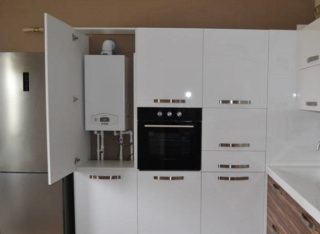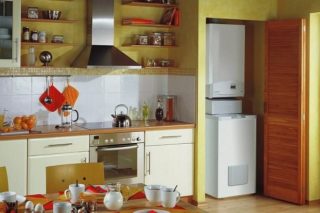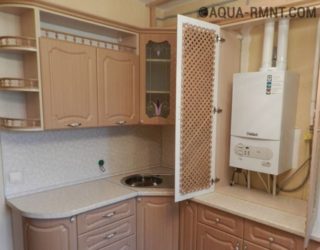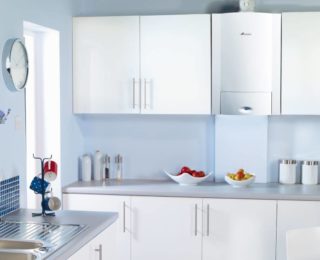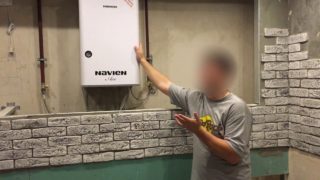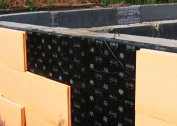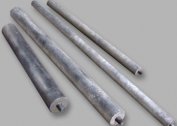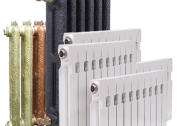Domestic gas water heaters can not always fit harmoniously into the interior of a room, especially if it is furnished in a country or classic style. In this case, property owners need to hide the gas boiler in the kitchen so that it looks impressive and security measures are followed. There are a number of interesting solutions that allow you to comply with current standards and maintain the design of the room.
Standards for premises and equipment
It is necessary to choose a heater after preliminary consultation with representatives of the management company so that the product parameters correspond to the conditions of the room where it is planned to be installed.
The following standards apply to the installation of autonomous water heaters:
- use only certified factory-made equipment;
- boiler power no more than 35 kW;
- pressure up to 1 MPa;
- coolant temperature up to + 95º;
- closed combustion chamber;
- availability of security automation.
No less requirements are presented to the kitchen space:
- the presence of working supply and exhaust ventilation;
- ceiling height not less than 220 cm if a gas stove is installed;
- the minimum volume of the room is 7.5 m³, with the addition of 2 m³ per burner;
- lack of combustible materials on the ceiling (stretch film or fabric, bulk figures made of foam);
- the presence of a window with a properly functioning window;
- door limiting the space of the kitchen;
- clearance between the floor and the door or a grill built into it with an area of at least 0.2 m².
Additionally, there are such restrictions on the distance from the water heater to the objects located in the kitchen:
- to the ceiling - 80 cm;
- before washing - 30 cm;
- to the hob - 10 cm;
- to the refrigerator - 50 cm;
- to the outlet - 100 cm;
- to the heating radiator - 70 cm.
Floor-standing appliances must be carefully aligned and secured to prevent them from tipping over or shifting. Wall products are hung on hooks with double safety margin. On all sides of the boiler, including the back side, it is necessary to leave a place that will be sufficient for a routine inspection, cleaning and maintenance.
Disguises for a gas boiler in the kitchen
There are several quite legal ways to hide the boiler in the kitchen so that it does not catch the eye and does not spoil the overall picture of the room. To do this, you can use one of the time-tested solutions that fully comply with the norms and rules of handling gas equipment.
Room Feature
Here we are talking about the layout, decoration, furniture and household appliances. If you put the boiler in a corner, and next to it is a large refrigerator or bar, the heater will not be visible, and access to it will remain open.
A good option is to adapt the product to wall decoration. Against its background, the painted heater will be almost invisible. For cladding, use heat-resistant paint or refractory film.
Another idea is to trim the heater under the kitchen. It is better to purchase linings at the stage of ordering furniture, then the part will definitely fall into place.
If the kitchen has a pantry, you can install equipment in it and make decorative ventilation holes in the doors.
Some house designs include niches in the kitchen.It is possible to hide equipment in it, if its dimensions allow you to leave the gaps stipulated by the technical conditions. If the niche is small, you can find a boiler of the appropriate size in the store. You may have to sacrifice power and compensate for its lack with a “warm floor” system or additional electric heaters. In such cases, everyone makes a decision individually, deciding what to give priority to - design or practicality.
Using drywall
GKL is an excellent way to close the water boiler beautifully and safely. The material is characterized by sufficient strength and fire safety. If necessary, it is given a curved shape, which makes it possible to efficiently and practically beat the space of the room. There is one limitation with respect to drywall - you cannot make stationary partitions that block access to equipment and block access to air. Designs can be removable, attached or opening type. The choice of this material makes it possible to abandon the additional surface finish near the boiler, since GCR is an excellent heat insulator.
To work, you need such tools and materials:
- grinder, screwdriver, hammer drill;
- roulette, level;
- pliers, hammer;
- scissors;
- putty knife;
- plaster, primer;
- headset
- mounting grid;
- steel profile and connectors to it;
- hardware (bolts, nuts, screws);
- paint brush.
The construction of a drywall box should be carried out in the following sequence:
- Take measurements, draw a drawing, apply markings on the floor, ceiling and walls.
- Saw the workpieces from GKL and steel profile.
- Assemble the iron frame by rigidly fixing it to the walls, ceiling and floor.
- Screw the walls of the box, assemble the door, cut holes in it or attach the ventilation grill.
- Treat the drywall with a primer, glue the joints with a grid, putty the holes from the screws with putty.
- Plaster the box, reinforcing the corners with plastic profiles.
- When the putty is dry, sand the surfaces, then coat them with a primer.
In conclusion, the finish is applied to the box. Depending on the features of the interior, it can be tile, adhesive film, wallpaper, leather or paint.
Using a kitchen set
The ideas to close the gas boiler in the kitchen cabinet are not innovative; they are used by many property owners. The disadvantage of this solution is that not all headsets are suitable for such purposes.
If the pencil case has suitable dimensions, it is enough to do the following:
- remove the back wall;
- cut holes in the bottom for supplying communications, and in the upper part for the chimney;
- install the equipment, hang it on the wall or fix it on the floor slab;
- connect the boiler, check its performance;
- make ventilation holes in the door and top panel;
- push the upgraded cabinet onto the boiler, firmly fix it on the hooks.
If the size of the elements of the kitchen set does not correspond to the parameters of the equipment, the cabinet can be made to order or independently. When working with your own hands, it is better to order only a door so that its color and texture exactly matches the appearance of the furniture facade. After this, the frame is made of timber or steel profile. Given the specifics of the equipment, it is better to dwell on non-combustible materials. Sheathing the frame on the sides is advisable with drywall. This will help to solve two problems at once: to strengthen the frame and create a layer of thermal insulation.
Communication and chimney masking options
Disguising a water heater is only half the solution. There remains a chimney, water and gas pipes.The appearance of these communications can significantly spoil the interior of the room, especially if the design in it is thought out to the smallest detail.
You can use one of the following options to hide pipelines coming from the water heater:
- Move the gas line to the corner where it can be covered with a plastic baseboard. You should choose modern products on latches to get access to the riser at any time.
- Close communications with a hard screen. The best solution is to use products such as blinds, with static or custom slats.
- Drown in the wall. This is allowed to be done only with electrical wiring and with plastic water pipes when there are no joints on the segment. Gates can only be done inside the walls.
- Collect the box. This event is affordable even for a beginner. For masking pipes, it is better to use light plastic, and for a chimney - refractory drywall. A prerequisite for both designs is the ability to quickly disassemble the box for inspection and maintenance of communications. In addition, the closed chimney must not overheat. There must be ventilation holes.
- Paint communications to match the color of the headset or wall. A good solution is to design a riser under a tree trunk.
When masking gas equipment, safety and legality of action must be paramount, adapting design issues to these aspects.
